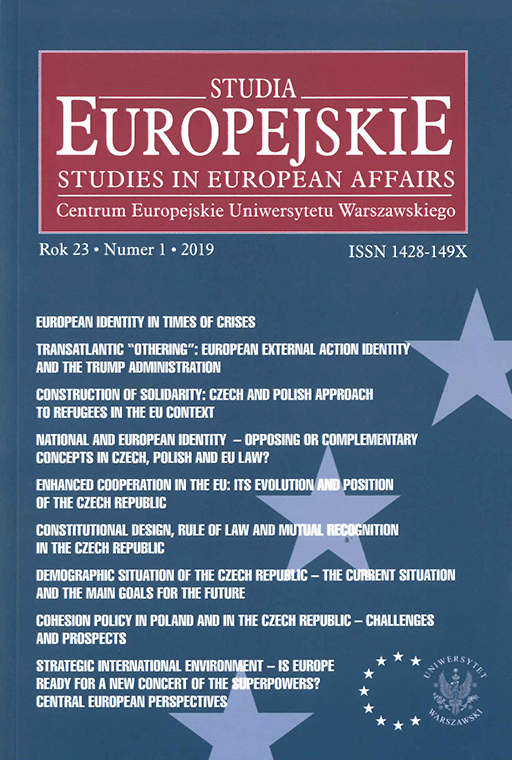
ISSUE: 1/2019
- Volume 23
- Number 1
- 2019
Subscribe NEWSLETTER
Studia Europejskie –
Studies in European Affairs
ISSN: 1428-149X
e-ISSN: 2719-3780
License
Articles published in the journal are under a Creative Commons Attribution – Non Commercial – No Derivatives 4.0 International License
Cohesion Policy in Poland and in the Czech Republic – Challenges and Prospects
Abstract
The aim of the cohesion policy is to accelerate the socio-economic development of Member States and their regions. Poland as well as its closest neighbour, the Czech Republic, have benefi ted from structural funds and the Cohesion Fund. The effects of provided aid have already become apparent but they differ given the scale of problems, including regional issues existing in these countries, and the amount of funds allocated. The aim of the article is to present the directions and the effects of the implementation of the cohesion policy in Poland and the Czech Republic with particular focus on the fi nancial perspective of 2007–2013. The results of
the evaluation of programmes for the years 2007–2013 show that EU funds are mostly spent on transport infrastructure. However, the support of entrepreneurship and innovation and human capital should be an important objective in the current programming perspective in order to transform and modernise the structure of economies.
References
Cohesion policy and the Czech Republic, October 2014, European Commission,http://ec.europa.eu/regional_policy/sources/information/cohesion-policy-achievement-and-future-investment/factsheet/ czech_republic_en.pdf.
Country notes: Czech Republic, OECD Regional Outlook 2016: Productive Regions for Inclusive Societies, OECD 2016, http://www.oecd.org/cfe/regional-policy/regional-outlook-2016-czech-republic.pdf.
Country notes: Poland, OECD Regional Outlook 2016, https://www.oecd. org/cfe/regional-policy/regional-outlook-2016-poland.pdf.
European Cohesion policy in the Czech Republic, European Union, http:// ec.europa.eu/regional_policy/sources/docgener/informat/country2009/ cs_en.pdf.
European Cohesion policy in Poland, European Union, http://ec.europa.eu/regional_policy/sources/docgener/informat/country2009/pl_en.pdf.
European Structural and Investment Funds: Country factsheet – Czech Republic, European Commission, April 2016, http://ec.europa.eu/regional_ policy/sources/policy/what/investment-policy/esif-country-factsheet/ esi_funds_country_factsheet_cz_en.pdf.
Eurostat news release 33/2018, 28 February 2018, Regional GDP per capita ranged from 29% to 611% of the EU average in 2016, https://ec.europa.eu/eurostat/documents/2995521/8700651/1-28022018-BP-EN/15f5fd90- ce8b-4927-9a3b-07dc255dc42a.
Gorzelak G., Fakty i mity rozwoju regionalnego, „Studia Regionalne i Lokalne”, no. 2(36)/2009.
Gorzelak G., Wykorzystanie środków Unii Europejskiej dla rozwoju kraju – wstępne analizy, „Studia Regionalne i Lokalne”, no. 3(57)/2014. https://ec.europa.eu/eurostat/data/database.
Jak państwa UE-15 korzystają z realizacji polityki spójności w krajach Grupy Wyszehradzkiej? Raport końcowy z badania pt. Ewaluacja ex post i prognoza korzyści uzyskiwanych przez państwa UE-15 w wyniku realizacji polityki spójności w krajach Grupy Wyszehradzkiej, IMAPP sp. z o.o., IBS, Warszawa 2017.
Kudełko J., Prusek A., Zieliński K., Europejska polityka spójności oraz jej efekty w Polsce, Wydawnictwo Uniwersytetu Ekonomicznego w Krakowie, Krakowie, Kraków 2011.
Murzyn D., Polityka spójności Unii Europejskiej a proces zmniejszania dysproporcji w rozwoju gospodarczym Polski, Wydawnictwo C.H. Beck, Warszawa 2010.
Ocena korzyści uzyskiwanych przez Państw UE-15 w wyniku realizacji polityki spójności w Polsce. Raport końcowy, Instytut Badań Strukturalnych 2017.
OECD Economic Surveys: Poland 2018, OECD Publishing, Paris 2018, http://dx.doi.org/10.1787/eco_surveys-pol-2018-en.
OECD Economy Surveys: Czech Republic 2018, OECD Publishing, Paris, https://doi.org/10.1787/eco_surveys-cze-2018-en.
Partnership Agreement for the Programming Period 2014–2020, Czech Republic, Ministry of Regional Development, 13 April 2016, http:// www.dotaceeu.cz/getmedia/4589b39c-4215-4f0b-914d-b296678db1c8/Partnership-agreement-technical-revision-approved-by-the-EC-on-13 -April-2016.pdf?ext=.pdf.
Partnership_Agreement.pdf. Regions and cities at a glance 2018 – Czech Republic, OECD, http://www. oecd.org/cfe/CZECH-REPUBLIC-Regions-and-Cities-2018.pdf.
Polityka spójności w okresie 2014–2020 a rozwój regionów Europy, eds. E. Pancer-Cybulska, E. Szostak, Prace Naukowe Uniwersytetu Ekonomicznego we Wrocławiu, no. 227, Wrocław 2011.
Programming of the 2014–2020 financial perspective – Partnership Agreement, 23 May 2014, Ministry of Infrastructure and Development, https://www.poir.gov.pl/media/9498/
Regions and cities at a glance 2018 – Poland, OECD, http://www.oecd.org/ cfe/POLAND-Regions-and-Cities-2018.pdf.
Smékalová L., Janiček P., Škarka M., Kozák V., Spatial concentration of the cohesion policy projects nationally delimitated intervention areas: the case of the Czech Republic and Poland, “Economics and Sociology”, vol. 8, no. 2/2015.
Tasks 3. Country Report Czech Republic, ex post evaluation of Cohesion Policy programmes 2007–2013, focusing on the European Regional Development Fund (ERDF) and the Cohesion Fund (CF), WP1: Synthesis report, Applica, Ismeri Europa and Cambridge Economic Associates, Publications Office of the European Union, Luxembourg 2016.
Tasks 3. Country Report Poland, ex post evaluation of Cohesion Policy programmes 2007–2013, focusing on the European Regional Development Fund (ERDF) and the Cohesion Fund (CF), WP1: Synthesis report, Applica, Ismeri Europa and Cambridge Economic Associates, Publications Offi ce of the European Union, Luxembourg 2016.
The impact of cohesion policy 2007–2013: in Poland, Visegrad Group Countries and partner states, Imapp, Warsaw 2017.
Language: English
Pages: 133-156
How to Cite:
Harvard
Dziembała, M. (2019) "Cohesion Policy in Poland and in the Czech Republic – Challenges and Prospects". Studia Europejskie – Studies in European Affairs, 1/2019, pp. 133-156. DOI: 10.33067/SE.1.2019.08